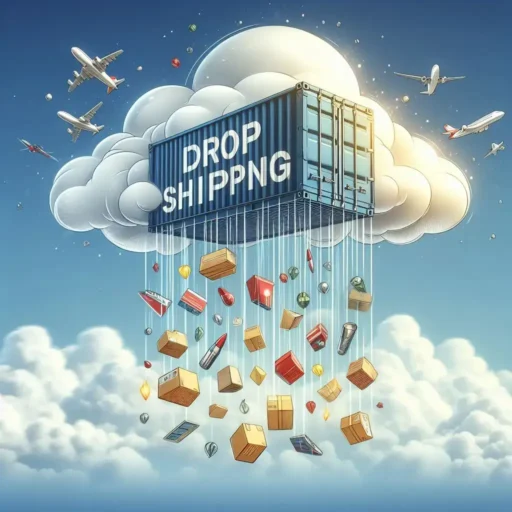Table of Contents
ToggleIntroduction to Drop Shipping
Drop shipping has revolutionized the way businesses operate in the e-commerce landscape. It is a retail fulfillment method where a store doesn’t keep the products it sells in stock. Instead, when a store sells a product, it purchases the item from a third party and has it shipped directly to the customer. This eliminates the need for inventory storage and allows retailers to focus on marketing and customer service.
How Drop Shipping Works
Drop shipping involves several key players: the retailer (you), the customer, and the supplier. When a customer places an order on the retailer’s website, the retailer forwards the order to the supplier, who then ships the product directly to the customer. The retailer makes a profit by selling the product at a higher price than the supplier’s wholesale price.
Advantages of Drop Shipping
Drop shipping offers several advantages for aspiring entrepreneurs:
- Cost-effectiveness: Since you don’t need to purchase inventory upfront, drop shipping reduces the initial investment required to start a business.
- Minimal risk: With no inventory to manage, there’s less risk of unsold products or dead stock.
- Flexibility and scalability: Drop shipping allows you to test multiple products and niches without committing to large quantities, and it’s easy to scale up as your business grows.
Challenges of Drop Shipping
While drop shipping has many benefits, it also comes with its fair share of challenges:
- Dependency on suppliers: Your business’s success relies heavily on the reliability and efficiency of your suppliers.
- Customer service issues: Since you’re not directly handling the products, resolving customer complaints and returns can be more challenging.
- Profit margin concerns: With intense competition and slim margins, maintaining profitability can be a constant struggle.
Choosing a Niche for Drop Shipping
Finding the right niche is crucial for drop shipping success. Conduct thorough market research to identify profitable niches with high demand and low competition.
Finding Reliable Suppliers
Partnering with reliable suppliers is essential for a successful drop shipping business. Look for suppliers that offer quality products, fast shipping, and good communication.
Setting Up an E-commerce Platform
Choose an e-commerce platform that supports drop shipping, such as Shopify or WooCommerce. Customize your store to reflect your brand and attract customers.
Marketing Strategies for Drop Shipping
Implement a variety of marketing strategies to drive traffic to your online store, including social media marketing, influencer collaborations, and search engine optimization (SEO).
Managing Orders and Inventory
Streamline your order fulfillment process and use inventory management tools to track stock levels and avoid overselling.
Customer Service in Drop Shipping
Provide excellent customer service to build trust and loyalty with your customers. Be responsive to inquiries and resolve issues promptly and professionally.
Scaling Your Drop Shipping Business
As your business grows, consider outsourcing tasks and automating processes to free up your time and resources for strategic growth initiatives.
Success Stories in Drop Shipping
Study successful drop shipping businesses to learn from their strategies and techniques. Case studies provide valuable insights into what works and what doesn’t in the world of drop shipping.
Common Misconceptions About Drop Shipping
Address common misconceptions and myths surrounding drop shipping to help aspiring entrepreneurs make informed decisions about pursuing this business model.
Future Trends in Drop Shipping
Stay ahead of the curve by keeping an eye on emerging trends and technologies in the drop shipping industry. Predict future developments and prepare your business to adapt and thrive in a rapidly evolving market.
Conclusion
Drop shipping offers a unique opportunity for entrepreneurs to start an e-commerce business with minimal risk and investment. By understanding how drop shipping works, overcoming its challenges, and implementing effective strategies, you can build a successful online store and achieve your entrepreneurial goals.
FAQs
Is drop shipping a profitable business model?
- While drop shipping can be profitable, success depends on various factors such as niche selection, marketing strategies, and supplier relationships.
Do I need technical skills to start a drop shipping business?
- No, you don’t need advanced technical skills to start a drop shipping business. Many e-commerce platforms offer user-friendly interfaces that make it easy to set up and manage your store.
How do I find reliable suppliers for drop shipping?
- Research potential suppliers thoroughly, read reviews, and reach out to them directly to discuss their products and services.
Can I drop ship products internationally?
- Yes, you can drop ship products internationally, but be aware of additional challenges such as shipping costs, customs regulations, and delivery times.
What are the biggest challenges of drop shipping?
- Some of the biggest challenges of drop shipping include finding reliable suppliers, managing customer service, and maintaining profitability in a competitive market.
Do you like to read more Blog content? Read our blogs at PintoraBlogs





